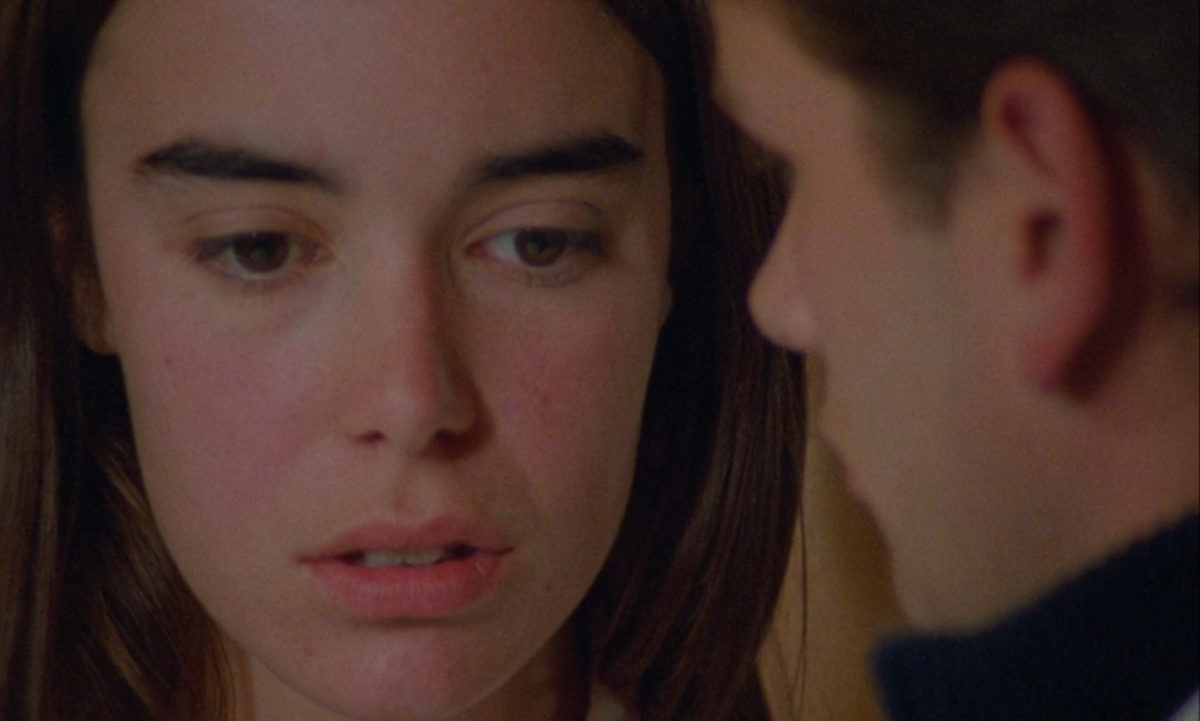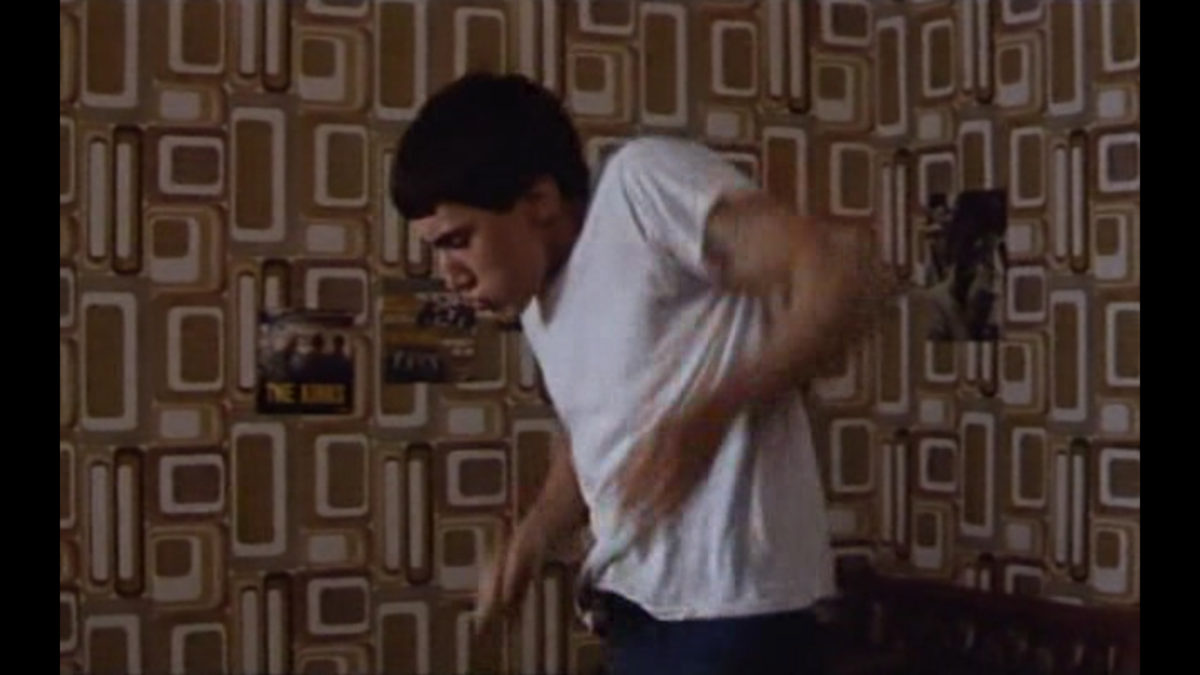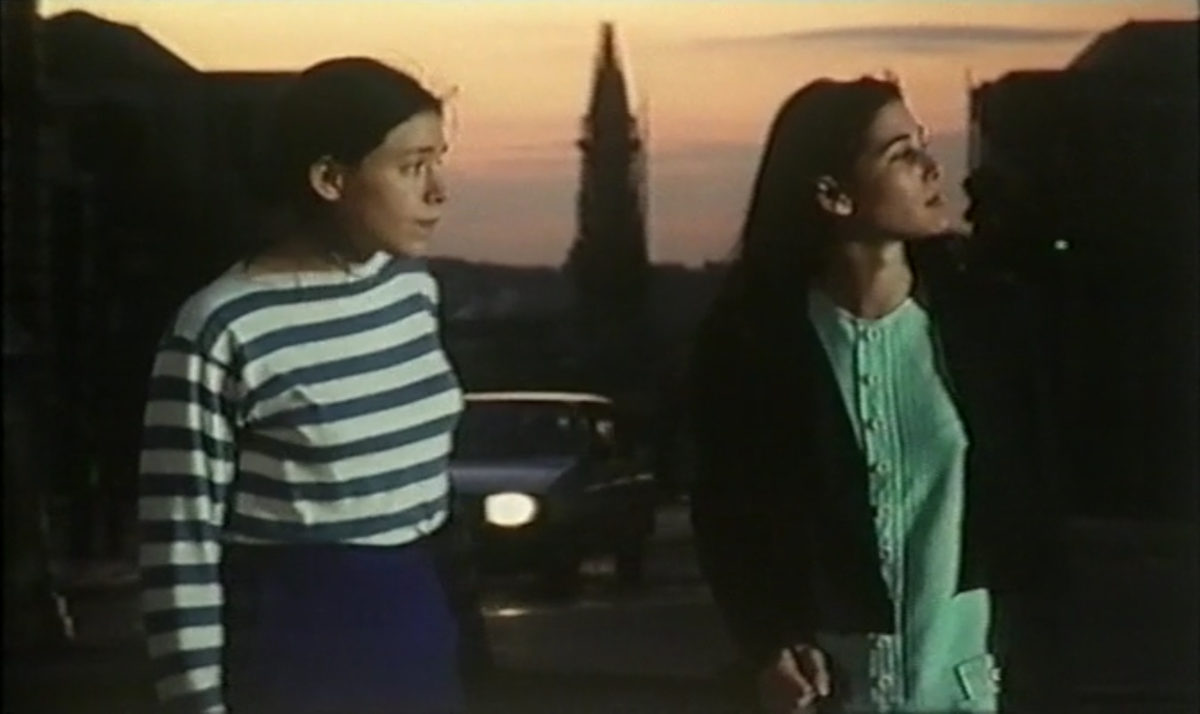Tous les garçons et les filles de mon âge
font ensemble des projets d’avenir
Tous les garçons et les filles de mon âge
savent très bien ce qu’aimer veut dire…
Comme les garçons et les filles de mon âge
Connaîtrai-je bientôt ce que c’est l’amour?
— Françoise Hardy, ‘Tous les garçons et les filles de mon âge’ (1962)
A common misconception is that the global wave of prestige television began in the early 2000s, with the advent of subscription cable and DVDs; it was already well underway a decade earlier, when film producers and directors began to get concerned about dwindling cinema attendance, largely caused by a revitalization of network TV and the cost-effective VCR. This renaissance in France took a particularly cinematic form, with upwards of a dozen series that borrowed leading directorial talent en masse from the big screen. Indeed, from a cinephilic perspective, nothing currently occupying the French airwaves could hold a candle to the cornucopia of auteurist series like Les années lycées (1994) and Gauche/Droite (1998), both of which proffered episodes that were in fact nascent feature films. The best-known example in the Anglosphere (although that’s not saying much, given how many of its episodes remain completely out of circulation) is ‘Tous les garçons et les filles de leur âge’ (1994), an anthology series conceived of by Chantal PopaudMother of Melvin (as seen in the films of Raúl Ruiz and François Ozon) and Yarol Popaud (who wrote the horrid theme song to these otherwise perfectly scored TV series). and produced by Georges Benayoun and Paul Rosenberg for ARTE. Airing on Friday nights over the course of late autumn 1994, it comprised nine films—meant to be five by men and five by women, but the last spot for a male director was never filled, despite initial interest from Philippe Garrel and Jean-Claude Brisseau, while Jacques DoillonSee Thierry Jousse and Frédéric Strauss, ‘Entretien avec André Téchiné’, Cahiers du cinéma 481 (June 1994) 12-17. Garrel and Brisseau opted out of the project early on; Jacques Doillon completed a film, Le Jeune Werther (1993), though ultimately not as a co-production with ARTE. never turned his in. They aired chronologically, taking the viewer from the early 1960s to the early 1990s, the periods in which they were set roughly coinciding with the filmmakers’ own adolescences.Le Chêne et le Roseau by André Téchiné (b. 1943) is set in 1962; US Go Home by Claire Denis (b. 1948) is set in 1965; Portrait d’une jeune fille de la fin des années 60 à Bruxelles by Chantal Akerman (b. 1950) is set in 1968; La Page blanche by Olivier Assayas (b. 1955) is set in 1972; Paix et amour by Laurence Ferreira Barbosa (b. 1958) is set in 1975; Travolta et moi by Patricia Mazuy (b. 1960) is set in the late ‘70s; L’incruste by Emilie Deleuze (b. 1964) is set in the early ‘80s; Bonheur by Cédric Kahn (b. 1966) is set in 1985; and Frères by Olivier Dahan (b. 1967) is set in the early ‘90s. The filiations and friendships between the various makers run aplenty. One particularly apt coincidence is that in a past life the ARTE executive who green-lit the series, Pierre Chevalier, was live-in babysitter to one of the directors, Emilie Deleuze (Gille’s daughter). More importantly, though, Chevalier had also been a top-ranking official of the CNC, the National Centre for Cinema and the Moving Image. His and Popaud’s devotion to art cinema made possible this unlikeliest of TV projects.
All the films in the series were shot quickly, over three weeks on average, and on Super 16, accepting frugality in exchange for creative liberty. The only rules they had to follow were to include both music from the period and a party scene. Ultimately, they were also united in their almost exclusive use of non- or not-yet-professional actors. (A notable exception is Grégoire Colin, who struggled to convince Denis he was right for the part; the subsequent fruits of their collaboration are, as they say, history.) From the surface of things, the main through-line between the nine films that comprise the 1994 TV series is simply late 20th century adolescence historicized, largely through the power of pop songs. But most of the films also share a basic story, that of how one boy or girl learns a crucial lesson about love in the course of a single day. The yearning to experience love was the subject of the Françoise Hardy tune from which the series borrows its title. However, the change of a single adjective, from “…mon âge” (my age) to “leur âge” (their age), reflects the series’ ambition of depicting the universality of the chanteuse’s sentiment. Every generation has had to learn what love is for themselves.
The cardinal sin of the teen movie is to idealize youth, to suggest vacuously that it is wasted on the young. The first four films in the series, discussed below in chronological order, evade this by aptly depicting adolescence as a period of deep suffering. However, they crucially don’t forget, either, all the blissful dreaming and freedom of the high school years.

LE CHÊNE ET LE ROSEAU
The opening film in the seriesWhile its October 21 airdate set the series into motion, it had already premiered at Cannes in a longer version: Les Roseaux sauvages was the closing film of Un Certain Regard, which also included the theatrical cut of Assayas’ episode, L’Eau froide. Cédric Kahn’s episode was the only other contribution to the series that enjoyed a theatrical release: its longer version, Trop de bonheur, was also in Cannes ’94, on its own in the Quinzaine des réalisateurs. Patricia Mazuy’s contribution, Travolta et moi appeared in the ACID sidebar but had in fact premiered the previous August at Locarno, winning the Bronze Leopard., Téchiné’s Le Chêne et le Roseau (The Oak and the Reed) is the most pedagogically-minded of the bunch. Other episodes feature classroom scenes and/or allusions to the characters’ academic struggles, but here studentship is as much the key theme as adolescence. One might reasonably chalk this up to a historical rupture between its period and those that follow. This was before the revolution, as it were; the youth maintained a degree of piety, at the very least to the temple of French letters. Classroom scenes take place toward the beginning and again at the very end of the TV cut (the basic structure of which is kept intact as the first half of the theatrical version, Les Roseaux sauvages/Wild Reeds). The former efficiently characterizes the three male leads: François (Gaël Morel) as the star pupil, whose only fault is a misplaced high regard for himself, Henri (Frédéric Gorny) as a clever but incorrigible reactionary, and Serge (Stéphane Rideau) as a doltish pretty-boy. The latter proffers a lesson on the La Fontaine fable that serves as the TV episode’s title and allegorically underlines its historical backdrop. The oak (which, in the 17th century, represented the king and in 1962 would likely have been seen as the French Empire) tells the reed that he pities its weakness. The reed answers that it’s more resilient than he knows. A storm comes and topples the oak, but the reed is still standing, just like Algeria would be after France’s bitter fight to retain control over it.
The struggle hovers over the film like a distant shadow, evoking a deeper social anguish beneath the layer of teenage growing pains with which the film is more directly concerned. While the subplot about Serge’s older brother deserting the French army feels slightly misplaced, the main storyline about the love triangle between Serge and François and Maïté (Élodie Bouchez) sure-handedly captures adolescent confusion about desire and fidelity. It’s ironic that Téchiné had forgotten he needed to include a party scene (which he cleverly alludes to, with Maïté saying to François that she forgot about her friend’s bash) because what he came up with is a tour de force. After her friend Colette has seen them walking by the venue, she pulls them in to boogie to Chubby Checker’s ‘Let’s Twist Again’. François then confesses to Maïté that he has been with someone else: a boy. The wistful melody The Platters’ ‘Smoke Gets in Your Eyes’ perfectly underscores Maïté’s heartache and inextinguishable warmth toward him, pictured through the tightest embrace. Then, a much-needed pick-me-up after the tense coming out: The Regents’ ebullient ‘Barbara-Ann’ (recorded in 1958, and released in 1961, years before being popularized by the Beach Boys).
Le Chêne et le Roseau shares with Assayas (who co-wrote several earlier films by Téchiné) an ambulant camera, most evident in the very first shot, which follows Maïté and François traversing a field. Téchiné has his cinephile outbursts, as in twin moviegoing scenes (first to Bergman’s Through a Glass Darkly, then to Demy’s Lola), but by the ‘90s he had fully grown out of being a film wuss, and the picture is rightly celebrated as one of his most mature works. At 57 minutes, it feels the most truncated of the first four episodes. However, French audiences had already experienced it as a fleshed-out feature. After premiering at Cannes, Les Roseaux sauvages proceeded to win the Prix Louis Delluc and the César for both Best Film and Best Director.
To varying degrees, in each of these films the build-up to or aftermath of parties synoptically dramatizes how characters reach a turning point on matters of the heart. The trope of the rager gone awry is a near teen-movie requisite. That the reputation of some of these films rests almost entirely on how compellingly they evoke the tumult of young-adult socializing reflects how much the filmmakers transcended the genre. Plenty of ink has already been spilt over US Go Home and L’Eau froide (Cold Water, the feature-length version of La Page blanche) but it’s the party scene in Chantal Akerman’s Portrait d’une jeune fille de la fin des années 60 à Bruxelles that most deftly serves as a fulcrum of the entire narrative structure of the film. (That it is similarly presented as the centerpiece of her 1997 self-portrait Chantal Akerman par Chantal Akerman suggests that she held it in equally high esteem.)

US GO HOME
Claire Denis’ contribution to the series would be worthy of celebration with only a fraction of the epiphanic moments that are packed into its lean 68-minute runtime. The fact that she only began shooting it at the end of June 1994 (merely weeks after the premiere of J’ai pas sommeil) and delivered it on-time to air on October 28, would be an absolute miracle for any lesser director. A subject for further research: how and when the screenplay was written, co-authored as it is by no less an icon of French cinema than Anne Wiazemsky. The film’s literary pedigree only calls attention to itself in one of the first scenes, when Alain (Grégoire Colin) reads to the camera from Seneca’s ‘De Brevitate Vitae’ (On the Brevity of Life). The next time we see him, he is erupting in a dance as indelible as Denis Lavant’s swaying at the end of Beau Travail (1999). The Animals’ classic ‘Hey Gyp’ animates his cartoonish gyrations that defy the rules of anatomy and gravity like Chuck Jones had with Road Runner.
Like all of Denis’ films, US Go Home is an intensely corporeal work, constantly scanning the legs and arms and faces and torsos of its characters. But the sequencing of early rock n’ roll tracks gives it a manic energy of its own, startlingly angular and electrified in comparison to her woozy soundtrack mainstays, the Tindersticks. Whereas Assayas’ L’Eau froide will operate according to a jukebox logic during its iconic party scene, US Go Home already does so for essentially its whole duration. Music offers a clear outline to the peaks and valleys of Martine (Alice Houri) and Marlène’s (Jessica Tharaud) night out, the goal of which is for Martine to lose her virginity. ‘Wooly Bully’ synopsizes the most innocent of teen parties, which the girls quickly ditch to get wasted with an older crowd. A sonic trifecta capitulates the experience: a lustful ‘How I’ve Loved You’, again by the Animals, briefly cedes to their even more sultry ‘House of the Rising Sun’ and then, once the girls have gotten comfortable, the Troggs’ euphoric single ‘With a Girl Like You’. As in L’Eau froide, songs mostly play for their entire duration, conveying a sense of real time that perfectly aligns the viewers’ experiences with the characters’.
Brushing up against the seemingly endless sea of couples dancing, the camera seems awash in sex pheromones. It conveys the kids’ every quiver and embarrassment that makes their hearts skip a beat. Though we feel Denis’ intoxication, we also witness the paradoxical coldness of this party culture, by which Denis purportedly had been revulsed at that age. The only niceties exchanged between the revelers are cigarette-sharing and spontaneous kissing.
Despite the initial dread Alain feels at seeing his sister turn up to the party, he shows his true colors in the awkward, yet deeply moving way that, after everyone else has fallen asleep, he sneaks up on her and embraces her, swaying with the languorous rhythm that hours and hours of slow dancing have drilled into him. They have one last ring of hell to pass through, though—getting a ride home. The title’s allusion to anti-U.S. imperialism articulates itself here, as an American soldier on the military base in their town (Vincent Gallo) lures them into talking to him with his sporty car and bulk supply of Coca-Cola. Their short drive, during which Alain keeps insisting upon his own Marxism, is as droll as the sequence at dawn of the soldier and the girl staring out into space ethereal.

PORTRAIT D’UNE JEUNE FILLE DE LA FIN DES ANNÉES 60 À BRUXELLES
While US Go Home is hardly a political film, it shares with the two other films set in the ‘60s a recognition of the continued militarization of France, a function of both the aftermath of WWII (which left many Americans stationed in Western Europe) and the Algerian War. If Le Chêne et le Roseau most directly engages with this reality, Portrait d’une jeune fille does most tangentially, through the character of a young Frenchman (Julien Rassam) who has deserted the army to visit a girl in Brussels. Once there, he falls in love with another, Michèle (Circé Lethem), our rebellious protagonist who ditches school to go to the movies and pick up lost boys like him, perhaps in an attempt to repress her nascent lesbianism. If this were not overtly autobiographical enough, the melancholy with which her every sentence is laced renders her a perfect foil to the filmmaker herself. “Even when I’m happy, I’m suffering,” she tells the boy. To his “I think I understand,” she replies, “That would shock me.”
The whip-smart dialogue is this episode’s crown jewel. In addition to long, romantic scenes of walking and talking that would make Richard Linklater blush, we receive a lesson from Michèle on Kierkegaard and see her flirtatious sleight of hand under a microscope. After they’ve already seemingly traversed half of Brussels and bore their hearts and minds, she brings him to a bistro, models what to order, and only then finally introduces herself by name.
Compared to the Denis and Assayas, the use of music appears sparing, but the mileage of each choice astonishes. Particularly salient is how Leonard Cohen’s ‘Suzanne’ lays the foundation for their first steps toward physical intimacy once they have retired to Michèle’s apartment. Akerman patiently accentuates every beat of their nervousness. An emblematic example is when they’re sitting on the edge of the bed, Michèle notes that it looks sad unmade and pulls the red blanket toward the pillows. Thereafter, with the gentlest of touches, Akerman implies she has lost her virginity; an unobtrusive cut whisks her from the bedroom to a city square at dusk, with the dimly lit streets traced by a pink horizon. Her best friend meets her there and they ride the tram to a party in the suburbs, where the film’s pièce de résistance unfurls: a circle dance to the tune of ‘La Bamba’. The most devastating moment in the film—perhaps in all of Akerman’s cinema—is the look of despair on Michèle’s face when, after some jubilant cavorting with her best friend in the center of the circle, her friend recedes back into the group. Tragedy turns, within a second, to comedy as Michèle shamelessly pulls her right back in. As sharp as the story of romance is, the film soars with the extremely convincing female friendship at its core. The deep love between them is palpable, though surely undetected by most of their schoolmates.

LA PAGE BLANCHE
In contrast to the preceding three episodes that all explore in some way the tension between platonic and romantic love, Olivier Assayas’ La Page blanche pits a couple against the world. Its opening scene—of Gilles and Christine racing and rambling through Monoprix, a wing-footed camera moving along with them but also giving them space to move into and out of the frame—inaugurates the shooting style that will become synonymous with Assayas.
“Extravagantes manoeuvres,” the teacher scrawls on the chalkboard in the following scene, lecturing on Rousseau’s Confessions, while the camera extravagantly maneuvers its way through the classroom as Gilles clandestinely sells the records he had shoplifted moments before. Gilles fled from the store without a hitch, but the authorities captured Christine and turned her back over to the mental asylum in and out of which she has been drifting. It’s worth noting that the first piece of music we hear in the episode is not any of the records Gilles has pilfered but rather a choral, yuletide affair playing on the TV in the hospital waiting room. Assayas often captures the seasons of the year as much as the epochal past or present of his fictions, and this work is no exception.
The soundtrack kicks into full effect a few scenes later. Though still remarkably fluid and visually compelling (note especially the above image that sets the affair into motion), the TV version’s more truncated party sequence feels a bit pre-fabricated, and it’s telling that the first thing Assayas determined about the sequence was its track listing: beginning with Janis Joplin’s ‘Me and Bobby McGee’ (“freedom’s just another word for nothing left to lose,” she famously croons, perhaps capturing the sentiment Assayas must have felt in loosening up his mise-en-scène after the failure of Une nouvelle vie), gaining some more steam through Creedence Clearwater Revival’s ‘Up Around the Bend’, and ending with Nico’s elegiac ‘Janitor of Lunacy’. An incontrovertible powerhouse, to be sure (and interspersed by six other ‘70s gems), but in order not to play like a suite for a jukebox Broadway musical, it needed the wondrous transitory moments of dialogue that are only present in the feature film.
Perhaps the greatest of these occurs during a poignant scene in which Gilles confronts Christine’s mother, who has shown up to the party after learning that she’s run away from the looney bin again. Most of the series’ episodes disclose little, if anything at all, about the characters’ progenitors, which is a shame, because the contrast between Gilles’ cultivated father and Christine’s unhinged parents (the father is a former soccer player who now splits his time between getting plastered at home and running a betting agency; the mother is a proud Scientologist, driving a car emblazoned with a Dianetics volcano and the slogan: “J’ai la joie de vivre, demande moi comment” [“I have a lust for life, ask me how”]) conveys volumes about their romance. Repeat viewings show that, beyond its blend of intoxicating nostalgia and psychic violence (the latter quality strongly reflecting the influence of ‘70s Bresson, especially Le Diable probablement, on Assayas), Cold Water also juggles a poetic sensibility (typified, on the surface level, by Gilles’ affected reading of Allen Ginsberg’s ‘Wichita Vortex Surtra’) with a sociological acuity worthy of Pialat.
The titles of the two cuts perform a deeper engagement with the interplay between words and images. In La Page blanche, the image of the revelers bopping to ‘Up Around the Bend’ as the bonfire flames soar conjures up the idea of the tabula rasa invoked by the episode title. The youth does not have hindrances, inhibitions, obligations, plans, or much of anything at all. L’Eau froide/Cold Water offers a more literal blank, white page, which Christine not only produces but in fact embodies. The final sequence comprises two awakenings. The first is Christine’s: she wades the flowing river and, somehow without a shiver, takes off her plain white shirt and walks back to their makeshift bed. Then, presumably some hours later, Gilles walks up alone and finds a paper folded up in Christine’s place. He walks with it to the river, standing just where she was at the start of the previous shot (thus establishing a visual rhyme between her and the page), and discovers it bears not a single trace.
* * *
In a rare instance of complete agreement, Positif and Cahiers du cinéma both celebrated the spontaneity these films exhibited, noting how it marked a turning point for both Téchiné and Assayas especially. Alas, the Denis and Akerman outings have received very limited exposure, as a result of barely circulating as standalone features. Outside of France, music clearance became a cost-prohibitive roadblock to these films’ distribution. Thankfully, the reputation of some has grown enough to enlist the help of deep-pocketed purveyors of cinema like the Criterion Collection, which beautifully restored L‘Eau froide.
In retrospect, the series is a fascinating testament to the alchemic powers that, in the right hands, TV can have. Financial differences between TV and film production can lead to wondrous opportunities. The most obvious example is here is the pernicious question of licensing. That, in France, music rights for TV series are a fraction of the cost for films gave the directors free-reign to line their works with wall-to-wall tunes. Denis, for one, admitted this was the main reason she agreed to participate. Record labels and youthful filmmakers have long made happy bedfellows, but instances in which the cream of both crops joined force with major institutional backing are rare. May ‘Tous les garçons et les filles de leur âge’ not be all the TV and the films of their kind.
